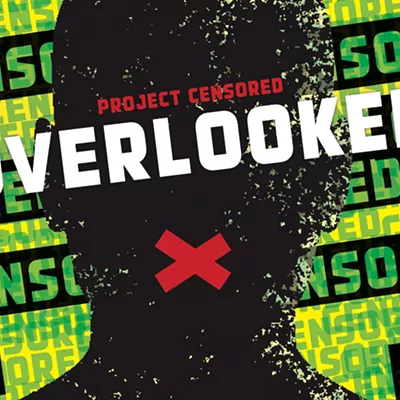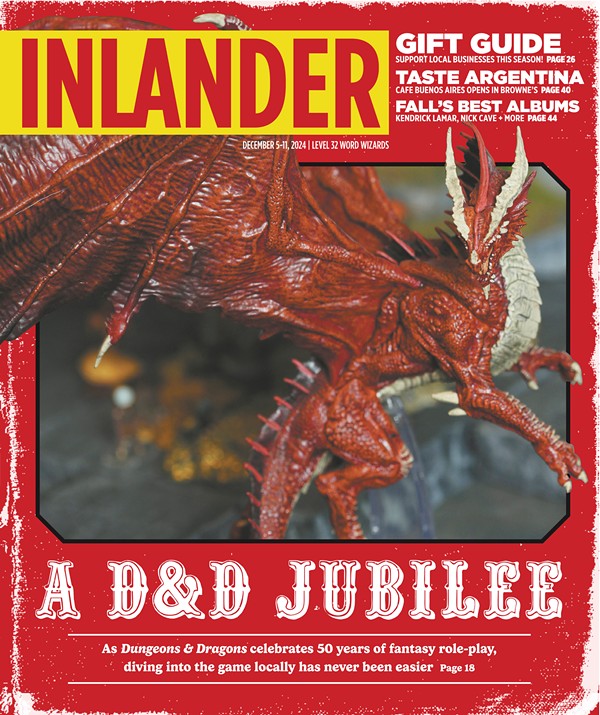A great big crock
[
{
"name": "Broadstreet - Instory",
"component": "25846487",
"insertPoint": "4",
"requiredCountToDisplay": "4"
},{
"name": "Broadstreet - Empower Local",
"component": "27852456",
"insertPoint": "8",
"requiredCountToDisplay": "8"
},{
"name": "Broadstreet - Instory",
"component": "25846487",
"insertPoint": "12",
"requiredCountToDisplay": "12"
},{
"name": "Broadstreet - Instory - 728x90 / 970x250",
"component": "27852677",
"insertPoint": "18",
"requiredCountToDisplay": "18"
},{
"name": "Broadstreet - Instory",
"component": "25846487",
"insertPoint": "5th",
"startingPoint": "23",
"requiredCountToDisplay": "24",
"maxInsertions": 100
}
]
by Ray Pride
Sometimes I stick around through a movie's ending credits because there are outtakes, with actors' crack-ups more natural and charming than anything in a lame comedy, or if there's a chance of a last joke before the end, or maybe just because the music's cool. With Crocodile Dundee in L.A., I wanted to check the copyrights and the banking arrangements.
I was seriously wondering if it was made for some startup airline hailing from some outpost of the former Soviet Union, or Mongolia maybe. While released theatrically in the U.S. by the shameless Paramount Pictures, you have to wonder how money is shifted about to put together this inanimate, spiritless, unwarranted sequel to the mostly forgotten, not-that-funny Paul Hogan fish-three-days-out-of-water comedies. A colleague and I sat in the dark as the bad music (without outtakes) played behind the credits, discussing possible scenarios, until ba-da-boom, the revelation: It's a Luxembourgese tax shelter. I haven't the time or diligence to examine that story, but let's just say it's far more intriguing that this embarrassment.
The jokes about Tom Arnold have more life than Hogan's features. Hogan looks all of 70, with dead eyes and a perpetually startled expression that seems the likely result of a really rotten bit of plastic surgery. His hairpiece is less convincing than his acting. And his enormous high-heeled cowboy boots seem less vanity than purest-grade delusion. While unmarried, Dundee has a young son, a Croc in the making. Linda Kozlowski, otherwise unemployed and playing his journo girlfriend once more -- heiress to a nonexistent Los Angeles edition of Newsday -- is almost unrecognizable on first glance, looking more like the missing Landers sister than the spunky would-be Irene Dunne character in the prior installments. Best line she gets to nod at: "Your paper's got police connections, right?" Which is hardly up to the film's apex of wit, "This isn't working -- what's the problem with the monkey?"
There's an incomprehensible plot about an upstart film production company that makes unprofitable junk sequels, with resemblances to both the film we're watching and the late Carolco Pictures (Cutthroat Island, Terminator 2) as well as the current Franchise Pictures (The Whole Nine Yards, Battlefield Earth). While presented as corrupt baddies, the characters are ensconced on the Paramount lot, using a logo that's almost the same as that of art distributor Paramount Classics. They're using their film productions to smuggle rare art from Eastern Europe. In an extravagant attempt at wit, the action star's name is "Jean-Paul Chagal," giving us a nudge -- ooh, ooh, this is gonna be about art!
The real art lies in the cameos by George Hamilton, seeming sozzled while sipping a martini and advocating coffee enemas to Hogan, or perhaps in Mike Tyson's scene, where he pops up in a Beverly Hills' Will Rogers Park teaching boy Croc how to meditate. An underlying homophobia in several scenes seems creepily unexamined, and one wonders whether it exists on the part of Hogan, the credited screenwriters, director Simon Wincer or Paramount. A few pointed questions might be lobbed in the direction of the lame PMS, mother-in-law, ex-wife and "bitch" jokes as well.
Action scenes toward the end are shot on backlot soundstages at night, and whether to mask the shabbiness of the choreography, or to hide that Steven Seagal was doing Paul Hogan's stunts, it's still like watching mud being smeared atop mud.
One of the credited producers is Lance Hool, a character whose name hasn't popped up much lately, although in the 1970s, he was one of the hands behind Caboblanco, an insane, unattributed remake of Casablanca, starring Charles Bronson. Bronson's 80 now and might have been more amusing, more lively, than Hogan. This is the kind of listless farrago that makes you wonder what country of what planet was the intended audience -- or, gasp! -- was it just all about the deal?
Sometimes I stick around through a movie's ending credits because there are outtakes, with actors' crack-ups more natural and charming than anything in a lame comedy, or if there's a chance of a last joke before the end, or maybe just because the music's cool. With Crocodile Dundee in L.A., I wanted to check the copyrights and the banking arrangements.
I was seriously wondering if it was made for some startup airline hailing from some outpost of the former Soviet Union, or Mongolia maybe. While released theatrically in the U.S. by the shameless Paramount Pictures, you have to wonder how money is shifted about to put together this inanimate, spiritless, unwarranted sequel to the mostly forgotten, not-that-funny Paul Hogan fish-three-days-out-of-water comedies. A colleague and I sat in the dark as the bad music (without outtakes) played behind the credits, discussing possible scenarios, until ba-da-boom, the revelation: It's a Luxembourgese tax shelter. I haven't the time or diligence to examine that story, but let's just say it's far more intriguing that this embarrassment.
The jokes about Tom Arnold have more life than Hogan's features. Hogan looks all of 70, with dead eyes and a perpetually startled expression that seems the likely result of a really rotten bit of plastic surgery. His hairpiece is less convincing than his acting. And his enormous high-heeled cowboy boots seem less vanity than purest-grade delusion. While unmarried, Dundee has a young son, a Croc in the making. Linda Kozlowski, otherwise unemployed and playing his journo girlfriend once more -- heiress to a nonexistent Los Angeles edition of Newsday -- is almost unrecognizable on first glance, looking more like the missing Landers sister than the spunky would-be Irene Dunne character in the prior installments. Best line she gets to nod at: "Your paper's got police connections, right?" Which is hardly up to the film's apex of wit, "This isn't working -- what's the problem with the monkey?"
There's an incomprehensible plot about an upstart film production company that makes unprofitable junk sequels, with resemblances to both the film we're watching and the late Carolco Pictures (Cutthroat Island, Terminator 2) as well as the current Franchise Pictures (The Whole Nine Yards, Battlefield Earth). While presented as corrupt baddies, the characters are ensconced on the Paramount lot, using a logo that's almost the same as that of art distributor Paramount Classics. They're using their film productions to smuggle rare art from Eastern Europe. In an extravagant attempt at wit, the action star's name is "Jean-Paul Chagal," giving us a nudge -- ooh, ooh, this is gonna be about art!
The real art lies in the cameos by George Hamilton, seeming sozzled while sipping a martini and advocating coffee enemas to Hogan, or perhaps in Mike Tyson's scene, where he pops up in a Beverly Hills' Will Rogers Park teaching boy Croc how to meditate. An underlying homophobia in several scenes seems creepily unexamined, and one wonders whether it exists on the part of Hogan, the credited screenwriters, director Simon Wincer or Paramount. A few pointed questions might be lobbed in the direction of the lame PMS, mother-in-law, ex-wife and "bitch" jokes as well.
Action scenes toward the end are shot on backlot soundstages at night, and whether to mask the shabbiness of the choreography, or to hide that Steven Seagal was doing Paul Hogan's stunts, it's still like watching mud being smeared atop mud.
One of the credited producers is Lance Hool, a character whose name hasn't popped up much lately, although in the 1970s, he was one of the hands behind Caboblanco, an insane, unattributed remake of Casablanca, starring Charles Bronson. Bronson's 80 now and might have been more amusing, more lively, than Hogan. This is the kind of listless farrago that makes you wonder what country of what planet was the intended audience -- or, gasp! -- was it just all about the deal?
















